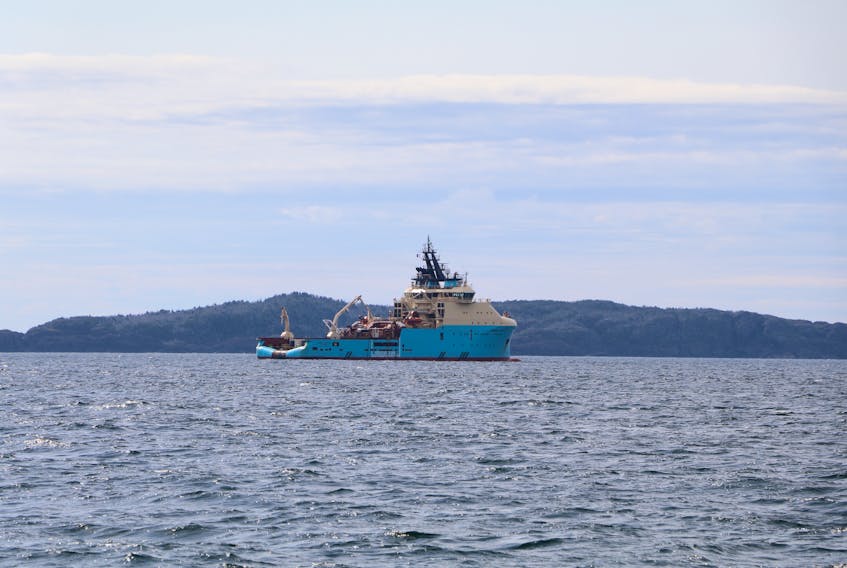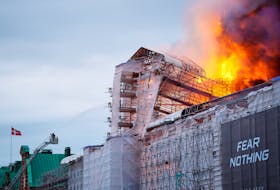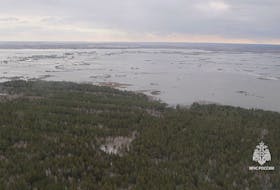The announcement Thursday of a $15.1-million contract for the removal of bulk oil from the Manolis L shipwreck near Change Islands in Notre Dame Bay has generated a lot of relief for local residents who feared a major oil incident along their coast.
It is the good news the many fishing communities along the province’s northeast coast have been waiting for, and a sense of accomplishment for the committee that has been leading the fight for the last four years to have the oil removed.
Carolyn Parsons, co-chair of the Manolis L Citizens Response Committee, said with funding announced in January the committee was expecting the announcement at some point this spring. But until the oil is pumped out of the wreck, she said, they will not be able to relax.
“It’s a big sense of relief, and it will be a bigger relief after it’s all done,” Parsons said. “We are very pleased. It’s been a long time coming.”
The federal government announced that the contract for the removal of bulk oil from the Manolis L shipwreck has been awarded to Ardent Global LLC. According to its website, the company is a specialist in emergency preparedness and response, wreck removal and offshore decommissioning. The company is the one that raised the cruise liner Costa Concordia off the coast of Italy.
Work will begin at the Manolis L site in July.
Dominic LeBlanc, minister of Fisheries and Oceans and the Canadian Coast Guard, said protection of the marine environment and the safety of those at sea are top priorities for the Canadian Coast Guard. Dealing with the pollution threat, he said, supports the Government of Canada’s commitment to dealing with wrecked, abandoned and hazardous vessels.
“It is essential to remove the threat of pollution currently posed by the Manolis L,” LeBlanc stated in a news release.
“We want to ensure that we have a healthy marine environment that can sustain important industries like fishing and tourism that our coastal communities and local economies rely on. We want future generations to have a great place to live and work.”
The Manolis L sank to a depth of more than 200 feet in 1985, and lay dormant until April 2013, when cracks in the hull, coupled with a powerful storm, allowed some fuel oil to reach the surface. Since then the Canadian Coast Guard has been monitoring the Manolis L and conducting pollution containment operations.
David Boyd of Twillingate was the first to report oiled birds in 2013. Boyd, a former fisherman, now operates a tour boat company called Capt. Dave’s Boat Tours, along with a fishery museum. The tours take visitors on cod fishing trips, and to see icebergs, whales and seabirds.
“At the start I noticed a duck down by my fishing stage trying to clean the oil off itself. That’s when I became aware of the leakage of oil,” Boyd said Thursday. “I’ve been on the water over 60 years, had my first lobster licence when I was six or seven, and like most people around here, our lives centre around the sea.
“The fear was that one of these days with a big sea, what we call a ground sea, metal rusts and gets fatigued, and it isn’t a matter of if but when the whole thing is going to break apart. A lot of oil has already come out of that ship.”
During a $5-million technical assessment carried out in the summer of 2016 by Resolve Salvage of Fort Lauderdale, Fla., it was discovered that much of the cargo of heavy fuel oils and diesel that was thought to have gone down and remained in the tanker had escaped — some of it at the time of the grounding and sinking through ripped-open tanks, while more was released gradually over the years through cracks in the hull.
The Manolis L sailed with 522 tonnes of oils onboard — combining both the diesel and the heavy oils. The amount remaining on board is in the range of 113 to 151 tonnes.
According to background in the technical assessment report, the Manolis L was a general 400-foot cargo vessel built in Germany in 1980. She was Liberian flagged, with a total of 25 cargo tanks for heavy oils, diesel or lube oil.
On Jan. 17, 1985, the Manolis L left Botwood about 5:15 p.m. en route to Chandler, Que., with a 2,990-tonne load of newsprint and fuel oils.
At about 10 p.m., the vessel was steaming full speed when it ran aground onto what is known locally as Blowhard Rock — between Bacalao Island and Change Islands — in stormy seas. The engine room and Hold 2 began to take on water and the vessel listed to port about 17 degrees.
The crew was evacuated by 2 a.m. the next day.
By Jan. 19, the stern of the vessel had submerged, though the bow remained afloat. On Jan. 20, the vessel slipped below the surface to a depth of about 200 feet and is presently capsized and resting against the Blow Hard rock formation.









